Step Back Into A Reality That Will Blow You Away
Outside a seemingly ordinary red brick building near downtown Tulsa, there are a few letters over the front doors, a charming font with the words Woody Guthrie Center. But those few words are certainly not anything that beckons loudly to enter. However, around the corner on the side of that building is a mural, giant in stature. That sends the message: “There is something important inside these walls, something you should see, someone in the history with whom you must get acquainted.” Many items inside this building are worthy of a few moments of everyone’s time. So much to see; in fact, it cannot be encompassed in one article.
This little gem with charming letters and a giant mural is home to the preservation of Woody Guthrie’s contribution to the arts and this country’s identity. Sadly, many of us only associate a single song learned in elementary school with this building’s namesake. It’s a good bet that many of us can still recite many of the words to This Land is Your Land. That alone speaks volumes as to this man’s contributions.
But this is only one small work of art from the man whose music, writings, musings, and art would influence so many others. Just a few of these include Bob Dylan, Joan Baez, Bruce Springsteen, John Mellencamp, and countless others who have used their talents to facilitate social change. It is impossible to gauge Guthrie’s global and historical influence. It is, however, with absolute certainty that his contributions to our understanding of the human suffering throughout the Dust Bowl tragedy are immeasurable.
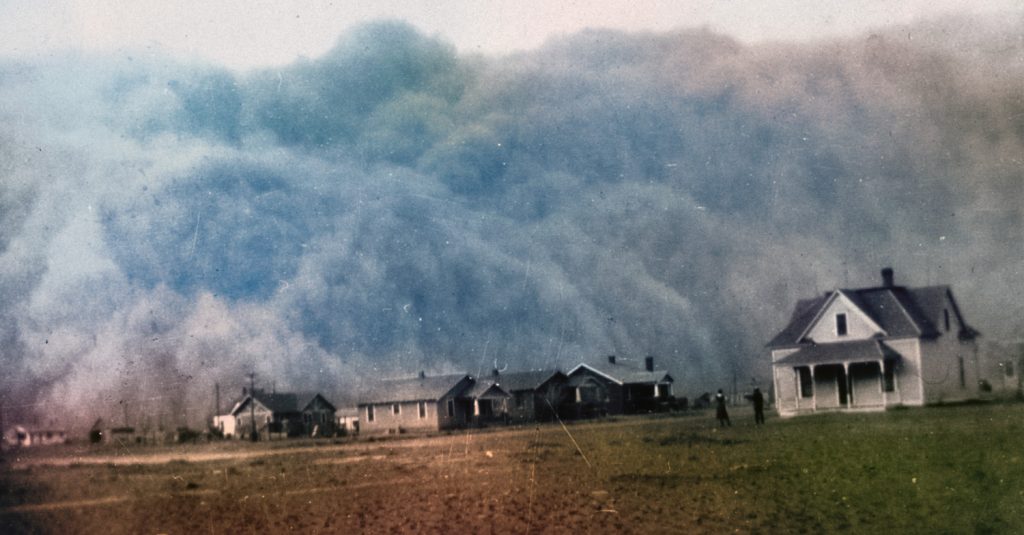
The Black Blizzard
Imagine a cloud so dark it turns day to the darkest of night. A black blizzard so powerful that it had the force to carry dust and dirt from the Oklahoma Panhandle to New York. Three million tons of topsoil blew across multiple states in one day alone. It seems impossible to fathom today, let alone a reality.
Yet, in our not-so-distant past, it was an absolute nightmare. It was a disaster of epic proportions for 1930s Oklahoma. Man-made environmental apocalypse brought on by an eight-year drought and poor farming practices that affected everyone from President Franklin Roosevelt to every farmer in the Great Plains prairie planting seeds in the barren ground. Farmers and their families donning face coverings and goggles to avoid dust, pneumonia, and blindness seemed reminiscent of those avoiding the Black Death during Europe’s Middle Ages. But there was no escape from the howling abrasive dust and destruction making its way into every crevice and corner of the times.
For years there would be little relief from the fallout as families lost their farms and often their very lives in the gale-force dust storms. Storms that took once-fertile prairie land and blew its dusty remnants to the corners of the country. Illness, poverty, and desperation seemed to be the only things left that flourished under the desolate soil. Roosevelt’s conservation programs and the rains would eventually lessen Mother Nature’s anger.
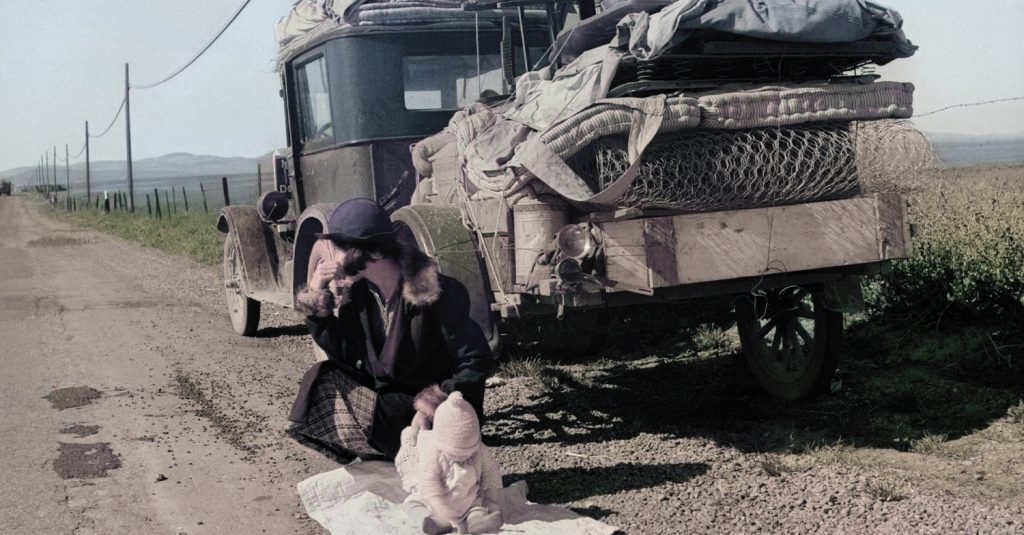
Giving Voice
As time passed and new national issues would take center stage, much of what happened would have likely gotten lost in a few pages of history. History that would have been lost between the Great Depression and WWII had it not been for a folk singer who witnessed the livelihoods of so many who withered and blew away into the nothingness. For this man, a record of the destruction had to be kept alive. He was giving a voice to the world, from those who weren’t being heard. Woody Guthrie became that voice through lyrics and melody.
What we see today in the Woody Guthrie Center stems from a seed planted all those years ago and then grown in the barren soil of Black Sunday when a 22-year-old Guthrie would witness nature’s fury from his home in Pampa, Texas. He later remarked, “You couldn’t see your hand in front of your face.” His first Dust Bowl song, So Long, It’s Been Good to Know Yuh, would be born from that experience. Other ballads would follow as he chronicled that day. These ballads were an expression of the experiences and the exodus of Oklahoma farmers out of the dust-torn areas that had once been home to beautiful prairie and wheat land.
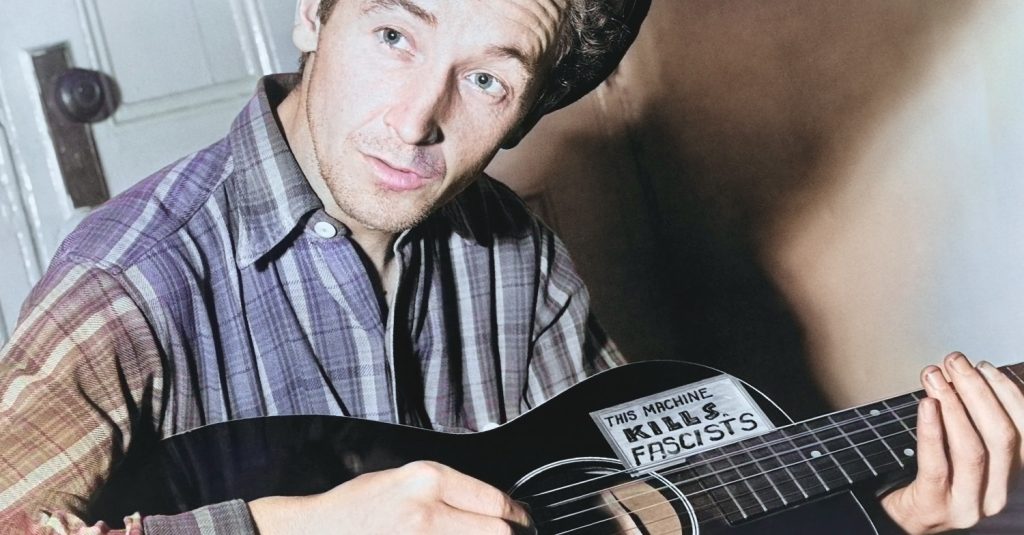
Traveling Time With Technology and
“Folks come from far and wide to see the Dust Bowl Exhibit,” Front House Supervisor for the center, Sam Flowers, said. He explained that the virtual reality aspect sets this apart from other exhibits. As he explains, it takes out the old boring classroom lectures and places us in the realistic midst of that era. When one takes a chair on the rickety old porch within the center and puts on the virtual reality headset, that person is transported back to April 14, 1935, the day became known as Black Sunday.
It’s a 360-degree view of what it was like on that day when the end of the world seemed at hand, and hell had been set free on the earth. There had been multiple dust storms over the plains in the preceding years encompassing multiple states and wreaking havoc from which there was no escape, but none even close to what was brewing in the skies that day.
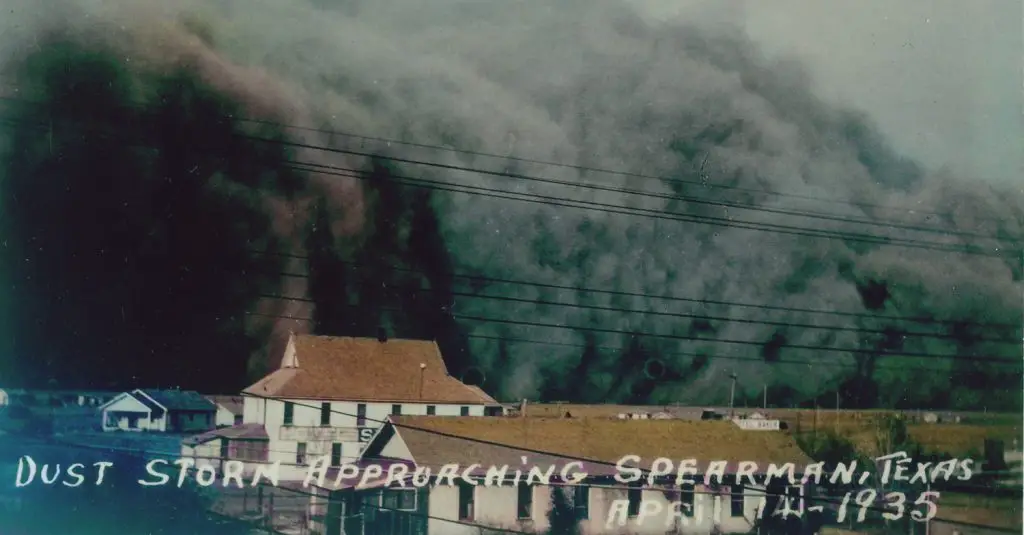
Inside the Storm
Survivors recall a glorious, beautiful morning that Sunday, one out of the norm of the constant winds blowing dirt into every crevice of their existence. It was a reprieve from the daily life of wet sheets over doorways and closed windows that brought little relief from the millions of dust particles that blew as a taunting plague. That windless, sunny morning made it seem as though God had held the winds and brought back the sunshine so the ravished families could remember hope. But it would be a short-lived hope. By afternoon, a cold front was moving across the Dakotas with a vengeance.
The winds were reaching fever pitch picking up the destroyed land and creating dust storms hundreds of miles wide and thousands of feet high. As the front zeroed in on Southeastern Colorado, Southwestern Kansas, and the panhandles of Texas and Oklahoma, all anyone could do was take shelter. This stormy darkness had swallowed up the morning sun, and any hope proffered. Death, destruction, and dirt drifts blocking entrance into homes were left in its wake. For many, nothing was left but a dusty road of uncertainty to the West. Woody Guthrie would join those misplaced and write and sing about their plight to find new lives in a place where the wind was no longer an enemy.
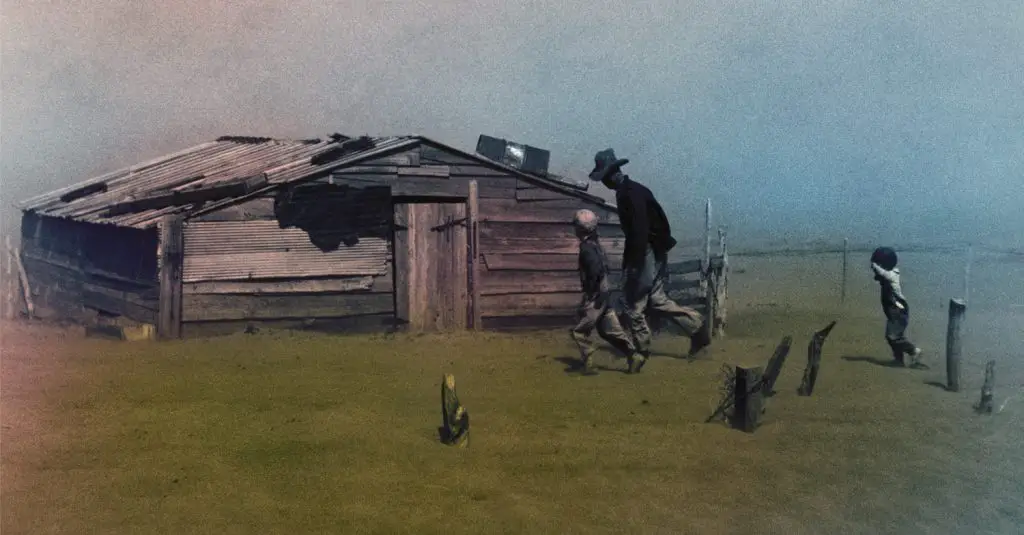
A Man Who Cared
Though the Woody Guthrie Center is so much more than just the Dust Bowl era, it is, I think, the centerpiece of a man’s life who cared so much for others and their sufferings. He made it his mission in life that they are recognized and never forgotten. This is the legacy of the man and the center which bears his name. As one wanders through the Woody Guthrie Center’s openness, they are humbled by the staggering amount of art he created throughout his life.
His efforts to make the world a better place and his hope that humanity treats each other with equality and respect are in everything he created. It is haunting to listen to his Dust Bowl ballads, take in the photos of the Dust Bowl devastation, and listen as survivors of those storms retell their experiences. These experiences are displayed in the Ken Burns documentary, The Dust Bowl, playing in one exhibit room’s background. It reminds us of why we must respect the past and celebrate those who document it for the ages.
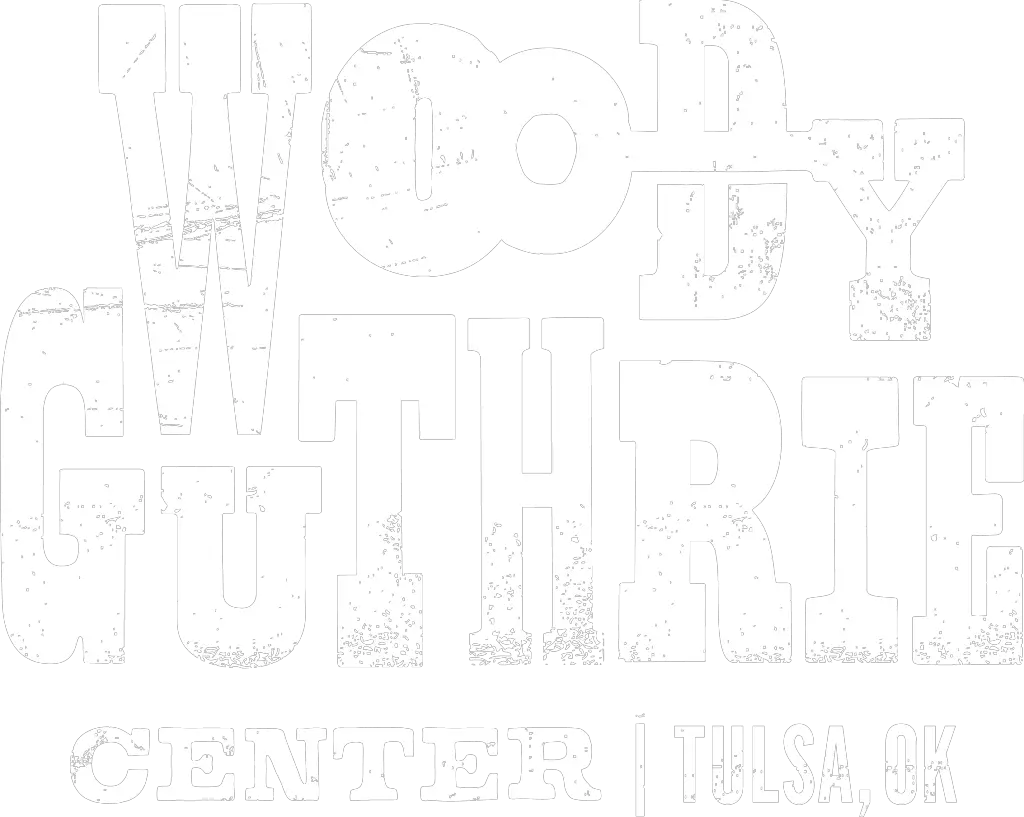
Educating and Preserving
The tragedy of Black Sunday and the Dust Bowl decade are alive today for us to experience in safety due to the efforts of the center’s Senior Archivist, Kate Blalack, and former Woody Guthrie Center Executive Director Deana McCloud. Their idea to create a reality-based learning experience from that era keeps that time alive; while also highlighting the impact of Woody Guthrie’s contributions to that time and history.
Blalack and McCloud co-wrote the grant proposal, which was awarded through the Oklahoma Humanities Council in 2017 with implementation in 2018. Blalack was also involved in transcribing the Dust Bowl oral histories for the Oklahoma Oral Histories Program before the exhibit’s existence. Her studies into Guthrie’s life and legacy bring unique knowledge and perspective to the center.
There were many facets to Guthrie’s life and to the center bearing his name, too many to cover in one article. Although this article focuses on the Dust Bowl exhibit, it is only a tiny part of what awaits those interested in learning about a man whose influences go beyond our comprehension. Learn from those who have made Guthrie’s contributions a part of their lives. Kate Blalack, Sam Flowers, and Quinn Carver Johnson are experts in the life of this historical treasure and those he influenced. They are more than happy to share their insight with everyone in their visual classroom for all ages.
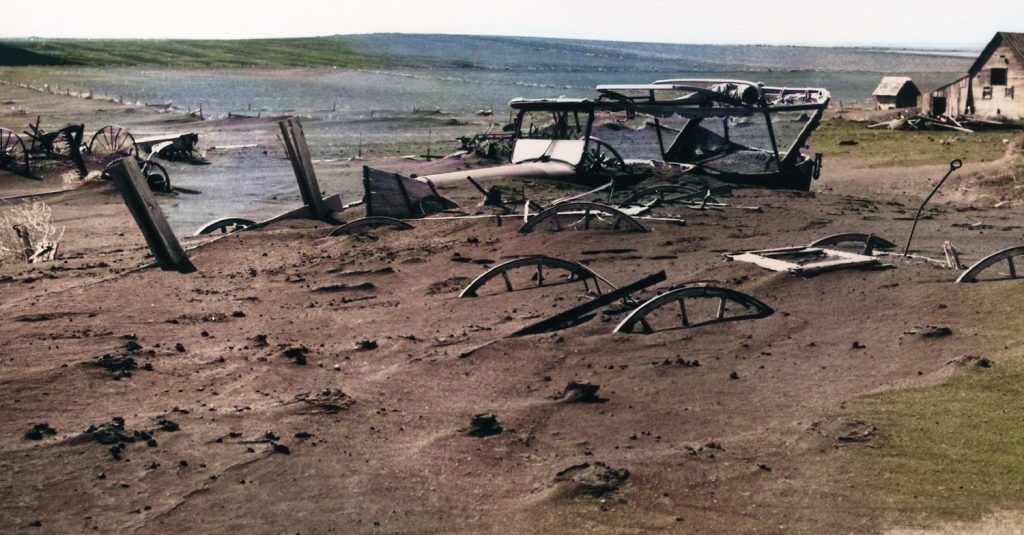
The Words
In the end, we are left with words. Some are remembered, some in books and poems, and others within melodies, but words have and will always define us. Guthrie knew this and used it even in the throes of Huntington’s disease when it was difficult to write even a single word. Even then, he continued to put them to paper. Of all that he had written, what resonates most with this fellow word lover is, “All of my words, if not well put nor well taken, are well-meant.”
I can think of nothing better for a man to write who chose a life of taking the darkness and shedding light on it. He wrote, “This Land is Your Land, This Land is my Land.”. Even when that land was barren of life and hope, it was still the land of the people he called his own in the state he called home.




Really enjoyed finding, and reading, this article! Thank you for making it available!
Thank you for reading! So happy you enjoyed the article!